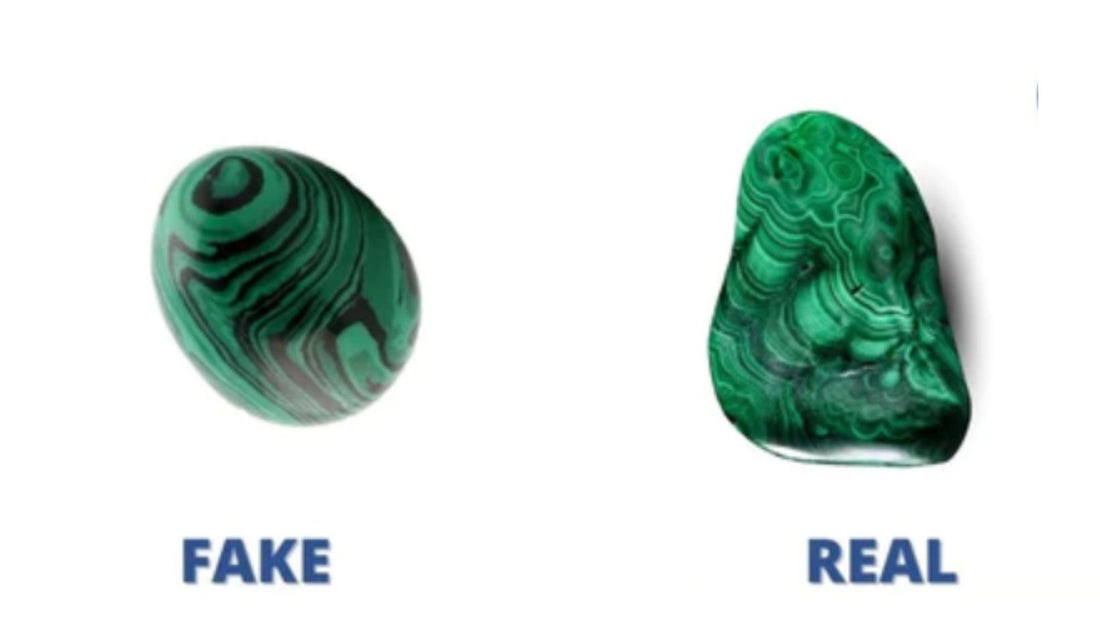
How to Spot a Fake Crystal
Share
One of the most common questions we get asked is "How can you spot a fake crystal" and while it can sometimes be difficult without the proper equipment, here are some things to keep an eye out to help you tell apart the real gems vs the fakes.
Commonly fake crystals
Malachite
Quartz: Rose, Smokey, Citrine, Clear
Turquoise
Moldavite
Amethyst
7 easy ways to spot a fake crystal
- Qwirky Names If a gemstone has an over the top name “melon moonstone” or “mountain top malachite” its probably your first red flag when choosing your next beauty. Don't get me wrong, some crystals out there have some interesting names however if it's unfamiliar to you or doesn't quite sound right, hopefully you can use some of the next tips to help you determine if its real or not.
- Perfect Patterns Like all humans, crystals are unique, no two are the same so if you are holding a piece of malachite and all the banding is uniform…put the stone down. The details will dance across and in most gemstones in the forms of cracks, flashes, rainbows and druzys. Some will even have natural holes (that's where the fairies live). They tell a journey of where your piece has travelled from, what its over come and what it has to offer you. Don't steer away from imperfections, lean into them, its what makes crystals unique

- Bubbly Boys Your crystal should not look like it’s had a bubble bath! Seeing bubbles in your gemstone is a really quick way to tell if what you are holding a real or fake. Please don't confuse this with natural imperfections. Closer examination can be done with a magnifying glass or jewelers loupe to look closer at the stone in question.
- Hardness The Mohs hardness scale is the perfect tool for telling if you are dealing with the real deal or a fakie. Every tangible thing in this world can fit onto the scale with baby powder being a one and diamonds being a ten. So what about gems? It depends on the gem. Glass sits at around a 5 on the scale whereas quartz tends to come in around a 7. The test is usually that anything higher on the scale can scratch anything lower on the scale, so a quartz gem could scratch glass. You may not want to perform a scratch test on your polished or tumbled stones but can be a good process with raw stones.
- Popping Hues While we all love beautiful bright pops of color, this could be a surefire sign that your crystal is dyed crystal or has been enhanced. This tends to be a common tip-off when your Citrine is sunshine bright or your Amethyst is positively popping with purple, and your Rose Quartz is vibrantly fuchsia. If you want to spot true Citrine from the burnt amethyst that is often passed off as Citrine, you want to look for a light lemon colour. That’s not to say that heat-treated crystals are fakes as they do hold energy as modified crystals, it may just be different energy to the one you thought you were getting.

True gems are more gentle in color and while some will still have a pop, the brightness won’t be blinding. It is worth noting that some gems like Carnelian, Red Jasper and Tourmaline do have a strong colour game but it's more the quartz crystals and the Fluorite that are softer in their natural shade.
- Glass vs Crystal Knowing how to spot glass from a gem can help you to stay true in the crystal game. This is common when it comes to Clear Quartz crystals as their name suggests, they have a clear and natural glassy look. However, if the stone is perfect and crystal clear without a blot, then it could be glass masquerading as a gem instead. Also remember, that crystals are heavier than glass so if your gem feels a little light to the touch, this could be another clue. Coloured or painted glass can be another common technique that is used as a stand-in for the real deal.
- Sourcing Who is your crystal hook up? One of the best ways to skip out on fake crystals and precious stones is to do due diligent research when it comes to your retailer. A good retailer relies on their reputation as a true crystal seller and they should be more than happy to back this up. You can check their social media, website or even reach out directly to ask!. Knowing the market price of precious gems also helps as you will be able to spot when a deal is too good to be true.
It's also quite common for real crystals to be enhanced to make them more appealing, stay tuned for our next blog on Human Enhanced Crystals.
Want to hear more? We also have an episode of The Crystal Basket After Live Podcast which covers how to spot a fake crystal as well.
We hope you found this helpful, leave a comment below on your real vs fake experiences

